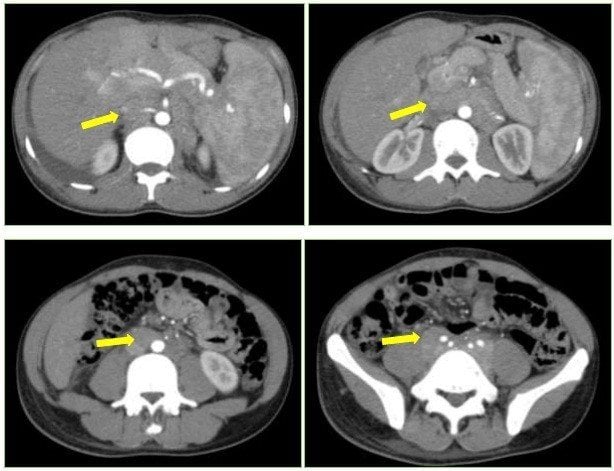Recently, a 36-year-old male patient came to the Nuclear Medicine and Oncology Center - Bach Mai Hospital ( Hanoi ) for examination due to difficulty breathing. The patient had a healthy history, no one in his family had malignant diseases. About 1 month before coming to the center for examination, the patient had difficulty breathing gradually, along with weight loss and fever in the afternoon. At the lower-level hospital, the patient was diagnosed with cervical lymph nodes, abdominal lymph nodes, and pleural effusion (pleural fluid had been aspirated many times).

Imaging in a patient diagnosed with diffuse large B-cell non-Hodgkin's lymphoma, stage 3B, follow-up of thyroid cancer
Upon arrival at the center, the patient was alert but tired, had limited physical activity, was thin (1m7 tall, 54kg), had many lymph nodes on both sides of the neck and armpits, the largest size was 1 x 2cm/lymph node. Through the results of examination, testing and imaging diagnosis, the patient was diagnosed with diffuse large B-cell non-Hodgkin's lymphoma, stage 3B; bilateral pleural effusion; monitoring for thyroid cancer, hepatitis B.
Professor Mai Trong Khoa, former Director of the Center for Nuclear Medicine and Oncology, shared that the first important thing is to accurately determine whether the patient has two different types of cancer or not, thereby determining an appropriate, safe and effective treatment strategy. For the above patient, after an accurate diagnosis, the patient was treated with a non-Hodgkin's lymphoma treatment regimen. After 6 cycles of chemotherapy combined with targeted therapy, the patient responded completely to the treatment and continued to be prescribed treatment for papillary thyroid cancer by total thyroidectomy, followed by I-131 and thyroid hormone replacement. At the same time, the patient is still regularly monitored for the first cancer (non-Hodgkin's lymphoma) and other related tests.
Second cancers are becoming more common
Regarding the frequency of cases of having two types of cancer at the same time, Dr. Ngo Truong Son, Deputy Head of the Oncology Department - Tam Anh General Hospital, Hanoi, said that researchers estimate that for every 20 people with cancer, about 1 person has another cancer at the same time. Second cancers are becoming more common because many people live longer after their first cancer diagnosis.
According to Dr. Ngo Truong Son, "simultaneous" cancer is when two tumors occur less than 6 months apart. It is even more common to have two different cancers at different times, that is, the second cancer occurs more than 6 months after the first cancer.
When a person has had cancer and develops a new cancer, it is called a second cancer or second primary cancer. This is a completely new and different type of cancer from the first one.
A second cancer is not the same as recurrent cancer (recurrence means the original cancer comes back, either in the original location or in another part of the body).
The treatment goal for people with two cancers at the same time depends on many factors and in specific situations, there will be appropriate treatment options.
To the question: "How to treat patients with two types of cancer at the same time to achieve the best results?", Dr. Son shared: "When two different types of cancer arise at the same time, doctors must decide which cancer to treat first. The principle of cancer treatment must still be based on the stage of the disease, histopathological characteristics, molecular biology, age, physical condition and associated pathology."
Treating a patient with two types of cancer at the same time is a challenge. Doctors will have consultations to discuss treatment strategies. In advanced disease, choosing cancer therapy is often difficult.
Usually, when two primary cancers occur at the same time, two different treatments are needed. The most life-threatening cancer will be treated first; or the easier-to-treat cancer may be treated first.
In patients in whom both tumors are likely to respond to the same anticancer regimen, the treatment decision will involve systemic therapy, such as chemotherapy. Alternatively, the two cancers may have pathological features that respond to the same targeted drug or chemotherapy (e.g., advanced gastric cancer and HER2-positive breast cancer both respond to Trastuzumab). For localized cancers, the strategy may be surgery or radiotherapy/chemoradiation for both malignancies.
Source link




































































































Comment (0)